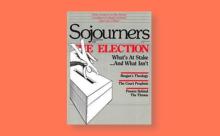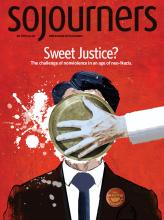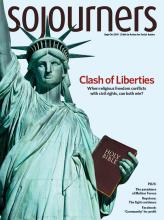Departments

OUR GOVERNMENT HAS taken the stance that Salvadoran “illegals” are economic, not political, refugees, and therefore have no right to be here. Despite stories and statistics to the contrary, our government doesn’t believe they have a “well-founded fear of persecution” that would entitle them to political asylum here. Meanwhile refugees keep coming with the same story of their government’s organized killing and repression. Where are our ears to hear and to respond? I am appalled at the inhumanity I see. I am standing in the belly of the beast, a monster we’ve created. ...
The core that sustains me is the still, small voice. It is God whom I wish to hear.

FORMER SAN FRANCISCO 49ers quarterback Colin Kaepernick was presented Amnesty International’s Ambassador of Conscience award this spring—previous winners have included Nobel Prize winners such as Nelson Mandela and Malala Yousafzai—for “his refusal to ignore or accept racial discrimination.” Kaepernick’s “take a knee” protests against police violence sparked a movement, across football and other sports, and they rest upon a rich tradition of athletes who have stood up for justice in the broader society.
Our cover feature this month looks at one of the pre-eminent justice issues for the players themselves, particularly in football: brain injuries. We talked with Dr. Bennet Omalu, the forensic pathologist who discovered pervasive brain trauma in NFL players. Omalu, whose research on chronic traumatic encephalopathy, or CTE, was chronicled in the 2015 Will Smith movie Concussion, argues in his latest book, Brain Damage in Contact Sports, that no child under 18 should play football.

On Aug. 8, 1943, the night before he was beheaded for refusing to fight for Hitler’s army, Franz Jagerstatter sat in a Berlin prison cell, deep in intimate prayer with God. On a table in front of him lay a piece of paper, a promise to serve in the Nazi medical corps. All he had to do was sign his name and the Nazis would let him live.
It was a simple choice. His guards encouraged him to sign the paper. His parish priest and bishop prayed for him to sign it and save himself. His wife and three little girls begged him to give up his one-man stand against imperial violence and sign the document so that one day he could come home.

EARLIER THIS YEAR, we lost theologian James H. Cone. “Yes, he was a world historical figure in contemporary theology, no doubt about that,” said professor Cornel West at Cone’s funeral, “a towering prophetic figure engaging in his mighty critiques and indictments of contemporary Christendom from the vantage point of the least of these ... But oh,” West added. “I think he would want us to view him through the lens of the cross—the blood at the foot of that cross.”
More than any other theologian, Cone taught us that we cannot divorce the gospel—Jesus’ suffering and redemption—from the history of violence against black people in the U.S. “Until we can see the cross and the lynching tree together, until we can identify Christ with a ‘recrucified’ black body hanging from a lynching tree, there can be no genuine understanding of Christian identity in America,” wrote Cone in The Cross and the Lynching Tree, “and no deliverance from the brutal legacy of slavery and white supremacy.”
The same week Cone died, the Equal Justice Initiative opened the National Memorial for Peace and Justice in Montgomery, Ala., the nation’s first memorial dedicated to the more than 4,400 victims of racial violence, including lynching, between 1877 and 1950.

HOW ARE WE to deal with the evil of sexism in the church and society? I believe Elizabeth Cady Stanton’s insight that there is no way of eradicating sexism from society unless it is eradicated from the church first is still valid, for the institutional church has a powerful influence in shaping society’s perception of reality. If it is perceived in the language, teaching, and behavior of the institutional churches ... that God is imaged only as male, then society has received religion’s example and approval of its oppression of women.

EVERY SUMMER, we pause our magazine work to spend a few days at The Summit for Change, a gathering of faith and justice leaders hosted by Sojourners. Held at historic Gallaudet University, The Summit is Sojourners’ homecoming for old friends and new and also a time to practice two overlooked justice activities: honoring and blessing.
The first group of people we honor at The Summit are elders, leaders who’ve paved the way for us to follow. The elders we’ve honored over the years—including Rep. John Lewis, Marie Dennis, Walter Brueggemann, Ruby Sales, John Perkins—are heroes. We thank them for their pioneering leadership, learn from their wisdom, and ask for their blessing on our own work.
But we also honor new leaders—folks whose names may not be widely known but whose commitment to social justice is unmistakable. We recognize them for their efforts to create a more equitable and peaceful world before we offer our blessing on their work that lies ahead.

[John Howard] Yoder suggests that texts such as “Do not be anxious” may be given in the context of the fallow year and that the prayer “Forgive us our debts as we forgive our debtors” should be interpreted far more literally than has usually been the case in praying our Lord’s prayer.

THE OLDEST mystics that we have in organized religious expression ... all have similar parabolic insights into contemplation. There is a story about the master saying to the disciples, “Tell me how you know when it is dawn.” And one disciple says, “Master, is it when we can tell the fig tree from the lemon tree at 100 paces?” And the master says to the disciple, “No, that is not how you will know it is dawn.”
So a second disciple says, “Well then, master, is it when you can tell the sheep from the goats at 50 paces?” And the master says, “No, that is not how we shall know when it is dawn.” Then the third disciple says, “Well then, master, how do we know that we have seen the dawn?” And the master says, “We will know that we have seen the dawn when we can see the face of Christ in the face of any brother or sister, no matter how near or how far.”
That’s contemplation. That’s the fruit of the contemplative life.
And unless you’re putting on the mind of Christ, I don’t know if you’ll ever see the face of the Christ in the other, or the face of the cosmic, or the face of the people of God in the other. You may be a highly efficient social worker or a marvelously compassionate do-gooder, but you will not necessarily be a Christian contemplative.
This is an excerpt of an article that originally appeared in the June 1987 issue of Sojourners. Read the full article here.

IN SEMINARY we “wrestled” with the problem of evil. Human evil. Systemic evil. The apparent evil of natural disasters. Drawing lines between the horrors wrought by an earthquake and the tragedy of an air crash caused by a mechanical failure. Tracing human culpability for the famine in Ethiopia. I wrote one dandy paper on the failure of process theology to deal adequately with the problem of evil. All at arm’s length, in the relative comfort of a “starving student’s” life.
It’s funny, in a way, that even though I already had worked for years with abused and neglected kids, their experience of evil rarely entered my college musings, at least not in any significant or sustained way. ... Guess what? This girl [an abuse survivor] doesn’t want my “problem of evil” package. Some do, you know. Some of the kids I’ve worked with will ask, “Where was God when I was being abused?” because they want desperately to hear that God was in the picture somewhere. Anywhere. ...
One thing is sure: I can’t “comfort” her into a faith in God. I can’t hope to find some new and dynamic arrow in the theological quiver that will penetrate the armor of her anger and disillusionment. I can’t hope to find some new stuff to put into those old packages. In fact, I have to fight every urge to tamper with my packages, and instead learn to leave them up on the shelf, where, for the most part, they belong.

When we consider the inferior status of women in Palestine in the first century ... Jesus’ attitude toward women is striking. Jesus revealed himself first to women after his resurrection. The disciples ... thought the women were just dreaming. Paul does not include the women in his list of witnesses to the resurrection (1 Corinthians 15:5-7). But the fact still remains: Jesus dared to appear first to women.
The incident of Jesus and the Samaritan woman at the well (John 4:7-30) has radical implications also. Here Jesus blatantly broke three customs: He, a man, talked to a woman in public. He, a Jew, spoke to a Samaritan. Finally, he instructed a woman in religion—a topic reserved only for men. When the disciples saw Jesus talking to this woman they were disturbed, but Jesus ignored them.
Even Paul’s words and actions must have been shocking to his first-century friends. Despite his injunction at one point that women should be silent in the church, he freely recognized women as leaders at other points. In Philippians 4:2 he commended Euodia and Syntyche and called them “fellow workers.” In 1 Corinthians he assumed women were prophesying and participating actively in worship. In Romans 16:7 he saluted Junia, a woman, as an apostle ... In Romans 16:1 he called Phoebe a deacon and, according to the best translation, he said, “she was designated as a ruler over many by me.”

IN THE TERM that begins this fall, the Supreme Court will hear the case of Masterpiece Cakeshop v. Colorado Civil Rights Commission. The nine justices will decide: Is a baker with sincerely held religious objections to same-sex marriage obliged—by anti-discrimination laws—to bake a wedding cake for a same-sex couple?
But underneath the frosting, the case exemplifies a much broader conversation in which religious liberty is pitted against civil liberties. In this ongoing fight, sides are often split down partisan lines, with conservatives championing religious liberty and liberals defending civil rights.
This religious-freedom-vs.-civil-liberties split is frustrating to many. After all, religious liberty isn’t just for conservatives; the First Amendment offers important protections to all people of faith, from Muslims who seek permits to build mosques to Christians who are conscientious objectors to war. At the same time, we care deeply about civil rights, especially in an era when so many Americans face discrimination because of their gender, sexual orientation, race, or ethnicity. In a nutshell, we want to support religious freedom for all while also protecting the civil liberties of LGBTQ folks and other minorities. But is that even possible?
Baptist minister and constitutional lawyer Oliver Thomas is optimistic, but not naive. In “Clash of Liberties,” he explains how religious liberty laws morphed from bipartisan efforts to ensure religious liberty for all into tools used by conservatives and liberals alike to press their own advantage. If we’re serious about protecting both, Thomas writes, we’re going to have to do something that’s easier said than done: lay aside our ideological differences and work for the common good.

HATRED HAS gotten a facelift. With the help of internet technology and cyberspace marketing, once-decrepit organizations like the Ku Klux Klan are regaining their youthful energy and competing for the attention of increasingly educated audiences. ... Behind the virtual makeover hides the same old-fashioned hatred that bigots have always promoted.
The internet has given hate groups ample reason to feel young again. In the United States, online bigots enjoy full protection under the First Amendment and have access to a potentially limitless audience. Webmasters are anonymous and difficult to silence; leaders suffer few consequences for their followers’ actions. And their strategies for organizational growth are beginning to look more corporate than cross-lit. ...
Virtual haters twist scripture into a white-power pretzel. The most common version of their convoluted hermeneutics is “Identity” thought, a theology that uses the Bible to justify racism and to prophesy apocalyptic judgment against non-white, non-Aryan races.
Identity sites are often eye-glazingly similar. Scripture is quoted at great length and with great gusto. Jews are the seen as the “anti-Christ” or “Satan’s seed.” Persons of color are deemed the “Unchosen” or “mud people.” Self-preservation of the white race becomes an imperative for true “Christians,” regardless of the personal costs involved.
This is an excerpt of an article that originally appeared in the September/October 2000 issue of Sojourners. Read the full article here.

WOMEN IN almost every culture and segment of society experience violence ... that is directed specifically at them as women. In the United States, women of color—Latina, African American, Asian, and Native American—experience violence that is specifically focused against them because of both their race and their gender. When misogynist violence combines with racism, the result is a unique and deadly threat to women of oppressed races. ...
Women of different races and economic backgrounds have begun to join together in a movement to end the violence that endangers them all. The women of color who are involved in this movement, however, bear witness to the barriers that hinder such cooperation. Prominent among them is the misunderstanding or ignorance of the particular ways that both individuals and institutions perpetrate violence focused against women of color. It is clear from the historical and current experiences of women of color that racism is an inextricable factor in this violence. They reject, therefore, analyses that blame only sexism and patriarchal structures for violence against women. The problem of misogynist violence can only be fully addressed when the experiences of all women are incorporated into the perspective of the movement for change. Both racist and anti-women stereotypes and attitudes must be overcome before society can become a safe place for all women.

[After 9/11] Many of us feel a deep desire for revenge and violent retribution. We know how natural that is. We want to strike back at the perpetrators. And it is true: We do need to find and punish them. But we must not let that need be overwhelmed by sheer rage. We need to counter those who want to bomb indiscriminately, to “take them out” with missiles, or even to use everything in our arsenal. ...
Can we together agree that retribution is not the way of Jesus? Can we remain steadfast in nonviolence, despite the skepticism of those who embrace violence as a way of fighting violence? Can we repudiate belief in redemptive violence? Christians must behave as Christians no matter how much our society and churches ridicule nonviolence as idealistic and ineffective. If we cannot be faithful in such a crisis as we presently face, when will we?
Finally, we must cling to God by blind faith in such a time as this. To the question, Where is God in all this? we can answer, Where God always is: nearer than breathing and closer than hands or feet. But just as the clouds of dust and smoke and falling debris blotted out the sun on Sept. 11, so horror of this dimension blots out the light of God. In such a time, we cannot perhaps feel God’s presence, but it is there, and we have to cling to it even as we scream at the silence of God.

WHILE Dr. Martin Luther King Jr. would be enormously proud of the strides our nation has made over the past 40 years, especially the country’s inspiring and groundbreaking election of our first black president, he would be calling on the president, the Congress, and all of us to mount a national, multiracial campaign to free the 36.5 million Americans of all races and places from the noose of poverty driven by low-wage work and to end racial disparities still prevalent in all areas of American life.
Today there are 36.5 million poor people in America, including 13 million children, although our gross domestic product is three times larger than in 1968. He would be pushing our new leaders, and all of us, to achieve long overdue health care for all, beginning with all children and pregnant women; to end the “Cradle to Prison Pipeline” that will afflict 1 in 3 black and 1 in 6 Latino boys born in 2001 unless we act together with urgency to dismantle it; to expand proven parent-child support programs and establish a high-quality comprehensive early childhood development system ...
We know what to do to end poverty, child illiteracy, and hunger and to ensure every child and person health coverage and job-rich, safe communities. Finding the spiritual and political will to do what is right and economically sensible and necessary is the challenge you and I and our new leaders face.

I AM Nancy Hastings Sehested, messenger from Prescott Memorial Baptist Church, pastor of Prescott Memorial Baptist Church, and servant of our Lord Jesus Christ. I am a full-blooded Southern Baptist. My mother is a Baptist deacon. My grandfather was a Southern Baptist minister for 70 of his 93 years. My dad is a retired Southern Baptist minister with 50 years of ordained ministry. ...
By what authority do I preach? ... It is not a new question. It is a question that was asked of our Lord Jesus Christ on a number of occasions. He had not the authority of the religious establishment, nor the authority of the state, but the authority of none other than the Holy Spirit that moved in his midst.
And so, by what authority do I preach and bear witness to my faith? ... By the authority of the Lordship of Jesus Christ, who did not count equality with God a thing to be grasped, but emptied himself, becoming a servant. And following in his footsteps, as a servant of Jesus Christ, who took the towel and the basin of water and exemplified the kind of servanthood that each one of us is called to live under, I found a towel with my name on it. And who was it that taught me this wonderful freedom of the Spirit? My Sunday school teachers. My pastor. My Southern Baptist church, who nurtured me and said, “God calls each one of us, so listen!” And so I listened.

"IF I HAD been a journalist at the time of the crucifixion, I would have been hanging around Herod’s palace talking to Pilate and disregarding [Jesus].” Out of the deluge of words spoken at the National Religious Broadcasters’ convention in Washington, D.C., in January 1978, this statement by Malcolm Muggeridge stood out. First, it had immediate personal relevance to this reporter: I was so busy chasing down celebrity Christians for interviews that if Jesus Christ had walked in, I certainly would have rushed by the out-of-place character. ...
At the time of the crucifixion, most Americans would have focused their attention on Herod, Pilate, their armies, their courts, and their rationales for doing what was “necessary” for law and order. Or for morality and family. Or for keeping the economy on an even keel. Or for the integrity and stability of the empire.
Most us of would have done it then, because we do it today. As good American citizens, and as reporters and as consumers of the news, we wittingly and unwittingly tag along with the crucifiers. We are fascinated with power.
The fascination with power carries over from our secular life to our religious life. Come Easter and the resurrection, we feel quite comfortable glorifying God the almighty, the omnipotent. We forget where we were three days earlier. We neglect our complicity in the cross event. And in the process, we ravel the whole fabric of Holy Week.

I AM NOT really sure about what it means to love God, but I do know what it means to be loved by God; and while God’s love for me is no guarantee against struggles, despair, or suicidal thoughts, it gives me the strength to take the next step. Psalm 139 has become one of my favorite statements about God’s love for me and presence in my life.
The psalmist proclaims, “Surely the darkness will hide me and the light become night around me; even the darkness will not be dark to you, the night will shine like the day, for darkness is as light to you” (Psalm 139:11-12). I am reminded by this proclamation that God is the ultimate reconciler of the contradictions of life. For even in the darkness God stands at the center and becomes as the light.
Because I am alive today I know that God has stood at the center of my despair and darkness and that out of that presence my will to continue was born. I am aware that I must simply be present to the power and love that have kept me from suicide, and that at the very core of my deepest despair or hottest rage stands God. I will be “held fast by his right hand” because there is no place that I can go either inwardly or outwardly where God is not already present. My hope is further undergirded by the knowledge that the contradictions of life in general and my life in particular are never final.
This article originally appeared in the April 1984 issue of Sojourners. Read the full article in the archives.

THE BOOK of Isaiah believes profoundly that God’s promises will prevail in, with, and through geopolitical reality. Note what an “unreal” long shot such a conviction is. I submit that only such a conviction can energize and authorize peacemaking. For without such a passion and certitude, we will soon or late succumb to realpolitik. Thus the root of peacemaking is a theological possibility and not a socioeconomic possibility. That is, the chance for peace rests in the trustworthiness of God and the issue of God keeping faith with God’s promises.
The text that authorizes this odd, subversive conviction has two features that are worth our noting. First, the text is poetry. It is not an argument about policy, but daring, inventive impressionistic rhetoric. Second, the text is poetry on the lips of God as a promise from God. That is, the speech of God is a beginning point for newness. The text, and every use of the text, is a political act as daring and as outrageous as was Martin Luther King Jr. when he said, “I have a dream.”
Peace is a dream that is uttered first on the lips of God, a dream that speaks against all settled political reality, an act of imagination from the throne of heaven in which we are invited to participate.
This article originally appeared in the May 1991 issue of Sojourners. Read the full article in the archives.
